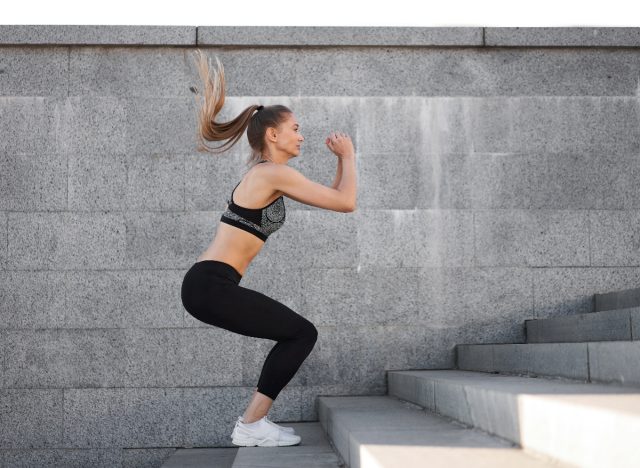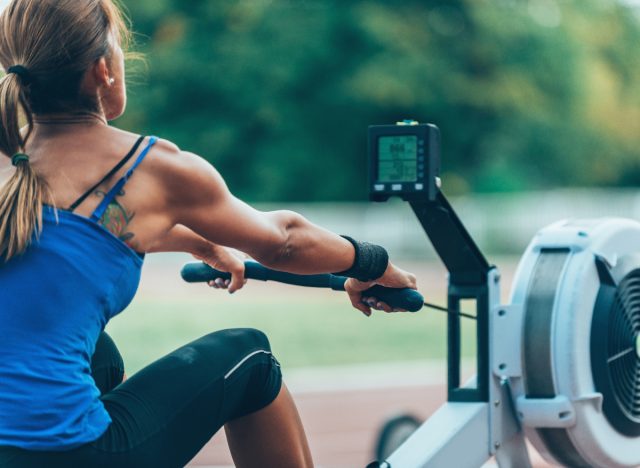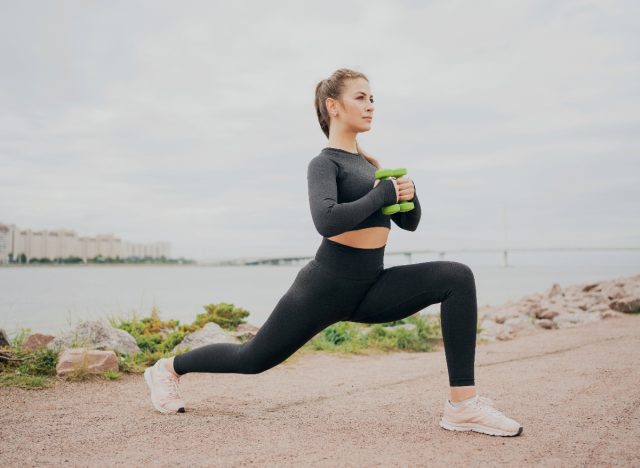Is It Bad to Do Only Cardio? An Expert Explains the Pitfalls—and What to Do Instead

For many fitness enthusiasts who are looking to shed extra weight or stay in shape, cardio workouts are a go-to form of exercise. Cardio workouts include aerobic activities such as walking, running, cycling, rowing, dancing, and more. Essentially, it’s any type of physical movement that gets your heart pumping and sweat flowing. But is it bad to only do cardio workouts for your fitness routine? Are there downsides to sweating it out on the treadmill or hitting the pavement for those long runs day after day?
To answer these common questions, we turned to fitness expert Destini Moody, RDN, CSSD, LD, a registered dietitian and sports dietitian with Garage Gym Reviews, who gives us the scoop on whether it’s bad or not only to do cardio workouts. Cardio exercises undoubtedly have no shortage of benefits, including supporting healthy weight management, improving your heart health, and boosting your mood. However, relying solely on cardio and neglecting other forms of exercise, like strength training or flexibility exercises, could lead to fitness plateaus, overuse injuries, or muscle loss.
Keep reading if you’re curious about the potential downsides of doing only cardio workouts and want to learn how to balance your fitness regimen better. And when you’re done, check out the 7 Best Cardio Exercises for Faster Belly Fat Loss.
What happens when you only do cardio for exercise?

A 2021 review in Nutrients concluded that performing aerobic exercise can lead to fat loss, but relying solely on this form of physical activity can also result in muscle loss and a reduced metabolic rate. This makes it more challenging to maintain or lose weight in the long run. In order to maintain muscle mass and maximize calorie burn, it’s crucial to incorporate strength training into your fitness routine. While cardio effectively burns calories, research shows that strength training helps preserve lean muscle and keeps your metabolism high.
“Steady-state cardio, like running for extended periods on a treadmill or elliptical, tends to burn fat but can burn muscle for energy if performed excessively,” explains Moody. “If gaining strength or building muscle is your goal, the body doesn’t respond well to cardio. That’s because the body needs a combination of weight-bearing from resistance training and a slight calorie surplus to gain muscle. Since cardio provides minimal resistance and actively works to burn calories simultaneously, it’s usually advised to keep cardio to a minimum for the most efficient gain in mass.”
What is the best type of cardio for weight loss?

Cardio workouts come in various forms—running, cycling, swimming, and more. When shedding those extra pounds, some types of cardio might be more effective than others. While all cardio exercises can contribute to weight loss, research points to high-intensity interval training (HIIT) as a top contender. HIIT involves short bursts of intense effort followed by brief recovery periods. This exercise not only burns calories during your workout but also keeps your metabolism elevated long after you’ve finished exercising.
“Numerous studies show that short bursts of intense exercise burn more body fat than moderate to low-intensity exercise over a longer duration, or steady-state cardio,” says Moody. “Additionally, HIIT burns twice as many calories as steady-state cardio. Scientists believe the reason for this is that HIIT tends to challenge the body more than just jogging or lightly running at a steady pace, and higher intensity of exercise means more fat burn. Additionally, by switching up the tempo and speed of exercise with the intervals in HIIT rather than going at a predictable pace, the body never gets a chance to burn just glycogen and resort to burning more fat than it would if you were doing steady-state cardio.”
What are the benefits of cardio workouts?

Cardio workouts, also called aerobic exercise, offer several health benefits. These activities get your heart pumping, boost your circulation, enhance your cardiovascular health, reduce your risk of heart disease, and improve your mental health. Furthermore, cardio workouts are fantastic for torching calories and supporting weight loss efforts when combined with a well-balanced diet. Whether you choose high-intensity interval training or a leisurely walk in the park, incorporating cardio into your fitness routine can have a profound impact on your physical and mental health.
Here’s why you should combine strength training and cardio.

While cardio torches calories and improves heart health, resistance training helps you build and maintain lean muscle mass. This muscle can boost your metabolism and help build a toned, fit physique. Combining resistance training with cardio can deliver a full spectrum of benefits, from improved endurance and fat loss to increased strength and bone health. So, rather than choosing one over the other, it’s best to embrace both for a well-rounded fitness regimen.
To get started, Moody says, “A weightlifting schedule of at least three to five days a week, each working a different muscle group, is a great place to start. If you choose to do HIIT training, stick to two or three days a week and no more than 20 minutes at a time, as more than this can start to dip into muscle breakdown territory. This can put your body in the best position to build or maintain muscle mass while keeping off fat and improving your body’s endurance and conditioning.”
- Source: https://www.ncbi.nlm.nih.gov/pmc/articles/PMC5556592/
- Source: https://www.nhlbi.nih.gov/health/heart/physical-activity/benefits
- Source: https://www.ncbi.nlm.nih.gov/pmc/articles/PMC8308821/
- Source: https://www.ncbi.nlm.nih.gov/pmc/articles/PMC4836564/
- Source: https://www.ncbi.nlm.nih.gov/pmc/articles/PMC8292807/
- Source: https://www.ncbi.nlm.nih.gov/pmc/articles/PMC8439678/
- Source: https://www.nhlbi.nih.gov/health/heart/physical-activity/benefits
- Source: https://www.axahealth.co.uk/health-information/exercise-and-fitness/boost-your-circulation/
- Source: https://www.ncbi.nlm.nih.gov/pmc/articles/PMC6481017/
- Source: https://www.ncbi.nlm.nih.gov/pmc/articles/PMC8020774/
- Source: https://www.niddk.nih.gov/health-information/weight-management/adult-overweight-obesity/eating-physical-activity
- Source: https://www.nia.nih.gov/health/four-types-exercise-can-improve-your-health-and-physical-ability
- Source: https://pubmed.ncbi.nlm.nih.gov/34536199/
- Source: https://www.ncbi.nlm.nih.gov/pmc/articles/PMC6279907/









